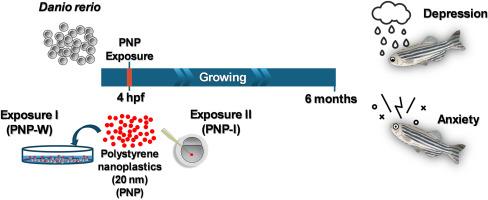Unseen threats: How nanoplastics trigger anxiety and depression-like behaviors in zebrafish (Danio rerio)
IF 7.3
2区 环境科学与生态学
Q1 ENVIRONMENTAL SCIENCES
引用次数: 0
Abstract
Nanoplastics (NPs) are emerging contaminants of global concern, widely detected in water, air, and food, leading to continuous and largely unnoticed human and wildlife exposure. Despite increasing evidence of their neurotoxic potential, the mechanistic links between NP exposure and the development of neuropsychiatric disorders remain poorly understood. This study investigates whether early-life exposure to 20 nm polystyrene nanoplastics (PNPs) contributes to persistent behavioral and neurobiological changes associated with anxiety and depression. Zebrafish embryos were exposed to PNPs exclusively during early development and raised for six months before undergoing comprehensive behavioral, metabolomic, histopathological, immunohistochemical, and gene expression analyses. PNP-exposed fish exhibited lasting anxiety- and depression-like phenotypes, including heightened stress reactivity, disrupted circadian rhythms, increased social clustering, and altered locomotion. Multi-omics analyses revealed neurotransmitter imbalance, oxidative stress signatures, neuronal degeneration, and apoptotic activation in brain tissues, alongside stress-axis hyperactivation and impaired antioxidant defenses at the transcriptional level. Together, these findings provide mechanistic evidence that early-life NP exposure may be an overlooked environmental risk factor for anxiety and depression. By integrating behavioral and molecular endpoints in a translational zebrafish model, this study underscores the urgent need for global monitoring of nanoplastic contamination and its potential implications for human mental health.

看不见的威胁:纳米塑料如何引发斑马鱼的焦虑和抑郁样行为(丹尼奥·雷里奥)
纳米塑料(NPs)是全球关注的新兴污染物,在水、空气和食物中被广泛检测到,导致人类和野生动物持续而不被注意的暴露。尽管越来越多的证据表明它们具有神经毒性,但NP暴露与神经精神疾病发展之间的机制联系仍然知之甚少。本研究调查了幼年接触20纳米聚苯乙烯纳米塑料(PNPs)是否会导致与焦虑和抑郁相关的持续行为和神经生物学变化。斑马鱼胚胎在早期发育阶段完全暴露于PNPs中,饲养6个月后进行全面的行为、代谢组学、组织病理学、免疫组织化学和基因表达分析。暴露于pnp的鱼类表现出持久的焦虑和抑郁样表型,包括应激反应增强、昼夜节律紊乱、社会聚集性增加和运动改变。多组学分析显示,脑组织中存在神经递质失衡、氧化应激特征、神经元变性和凋亡激活,以及应激轴过度激活和抗氧化防御在转录水平上受损。总之,这些发现提供了机制证据,表明生命早期NP暴露可能是焦虑和抑郁的一个被忽视的环境风险因素。通过在斑马鱼模型中整合行为和分子端点,本研究强调了对纳米塑料污染进行全球监测及其对人类心理健康的潜在影响的迫切需要。
本文章由计算机程序翻译,如有差异,请以英文原文为准。
求助全文
约1分钟内获得全文
求助全文
来源期刊

Environmental Pollution
环境科学-环境科学
CiteScore
16.00
自引率
6.70%
发文量
2082
审稿时长
2.9 months
期刊介绍:
Environmental Pollution is an international peer-reviewed journal that publishes high-quality research papers and review articles covering all aspects of environmental pollution and its impacts on ecosystems and human health.
Subject areas include, but are not limited to:
• Sources and occurrences of pollutants that are clearly defined and measured in environmental compartments, food and food-related items, and human bodies;
• Interlinks between contaminant exposure and biological, ecological, and human health effects, including those of climate change;
• Contaminants of emerging concerns (including but not limited to antibiotic resistant microorganisms or genes, microplastics/nanoplastics, electronic wastes, light, and noise) and/or their biological, ecological, or human health effects;
• Laboratory and field studies on the remediation/mitigation of environmental pollution via new techniques and with clear links to biological, ecological, or human health effects;
• Modeling of pollution processes, patterns, or trends that is of clear environmental and/or human health interest;
• New techniques that measure and examine environmental occurrences, transport, behavior, and effects of pollutants within the environment or the laboratory, provided that they can be clearly used to address problems within regional or global environmental compartments.
 求助内容:
求助内容: 应助结果提醒方式:
应助结果提醒方式:


